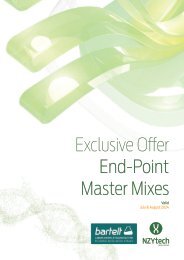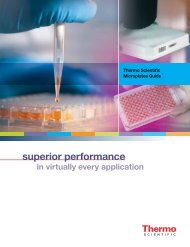PeloBiotech
You also want an ePaper? Increase the reach of your titles
YUMPU automatically turns print PDFs into web optimized ePapers that Google loves.
www.pelobiotech.com<br />
Dyes<br />
You can find a wide range of dyes for microscopy that can be used to stain various<br />
cellular organelles, proteins, membranes, and nucleotides.<br />
There are live cell dyes available that allow for organelle visualization with organelleselective<br />
stains (e.g. ER, mitochondria, Golgi) or function assays like, e.g. live cell<br />
tracking, labeling, cell proliferation, or live dead assays.<br />
You may find a brief overview of our product range in the table below:<br />
Product<br />
NucleoSeeing<br />
CytoSeeing<br />
ERseeing<br />
LipiDye<br />
FAOBlue<br />
Thermoprobes<br />
Ap3<br />
PolyamineRED<br />
Application<br />
Live cell imaging, cell cycle studies, DNA damage assessment, environmental stress studies, drug<br />
screening, cell viability assays, cell sorting and isolation, cancer research, intracellular pH<br />
monitoring<br />
Our microscopy dyes provide live cell visualization without compromising cell viability. They<br />
allow tracking of cell division and migration, co-staining with other probes, and are suitable<br />
for FACS or flow cytometry analysis.<br />
A permanent endoplasmic reticulum (ER) staining dye is a versatile tool for cellular research<br />
and diagnostics. It aids in studying ER morphology, monitoring cellular health, assessing ERrelated<br />
diseases, evaluating drug effects, diagnosing conditions, and enabling precise cell<br />
sorting.<br />
Our specialized lipid detection dye is essential for imaging live and fixed cells, particularly for<br />
staining tiny lipid droplets smaller than 1 micrometer, a task often challenging for conventional<br />
dyes like Nile Red.<br />
This unique capability is invaluable in lipid metabolism and cell biology research, enabling<br />
detailed insights into cellular processes, lipid dynamics, and lipid-related disorders like obesity<br />
and diabetes.<br />
Our fatty acid oxidation detection dye simplifies live cell imaging and offers insight into singlecell<br />
metabolic activity. Its applications extend to NASH research, allowing for the assessment of<br />
liver cell lipid metabolism, as well as broader metabolic studies for treatments and disease states.<br />
This dye is ideal for real-time, dynamic metabolic observations and interventions in metabolic<br />
disorders.<br />
Our live polymeric thermometer dye provides real-time intracellular temperature insights for<br />
living cells, making it a valuable tool in fields like cancer research, neuroscience, and drug<br />
development. It allows researchers to study cellular responses to treatments and conditions,<br />
uncover temperature regulation mechanisms, and understand how temperature fluctuations<br />
impact cellular processes, all in a non-invasive and continuous manner.<br />
Our SHG detection dye is essential for enhancing true SHG signal detection and enabling<br />
multimodal imaging. It has applications in neuroscience for visualizing neural structures, in tissue<br />
engineering for studying extracellular matrix components and cell interactions, and in material<br />
science for analyzing material properties and molecular arrangements. This dye plays a crucial<br />
role in advancing research in these diverse fields.<br />
PolyamineRED is a powerful tool for the non-invasive, semi-quantitative detection of<br />
intracellular polyamines without the need for pre-treatment or cell lysis. This versatile dye finds<br />
applications in diverse fields, including cancer research, neurobiology, and drug development.<br />
It enables the study of polyamine levels and distribution within live cells, offering insights into<br />
cancer progression, neuronal function, and the evaluation of potential drug candidates targeting<br />
polyamine-related pathways.<br />
64
















